Organizational Behaviour: Effects of Culture, Politics, and Power on Behaviour and Motivational Techniques for Goal Achievement
VerifiedAdded on 2023/06/07
|14
|4789
|232
AI Summary
This report evaluates the effects of organizational culture, politics, and power on behaviour and performance of individuals and teams, as well as motivational techniques for goal achievement. It discusses the different types of organizational culture, the impact of organizational politics, and the various powers used by managers. The report also evaluates content and process theories of motivation, including Maslow's hierarchy of needs theory and Vroom's expectancy theory, and what makes an effective team. The case study used is Marks & Spencers, a British multinational retailer.
Contribute Materials
Your contribution can guide someone’s learning journey. Share your
documents today.
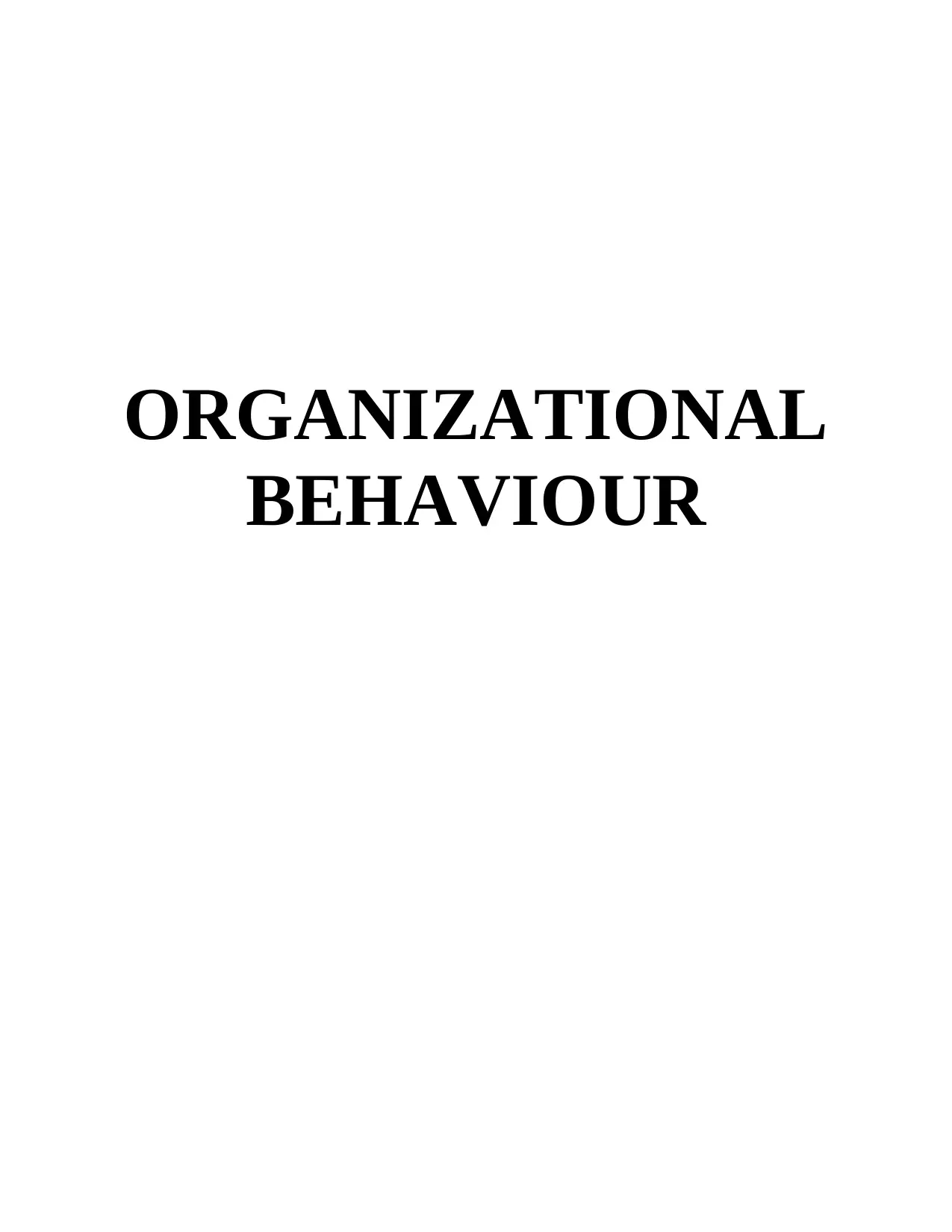
ORGANIZATIONAL
BEHAVIOUR
BEHAVIOUR
Secure Best Marks with AI Grader
Need help grading? Try our AI Grader for instant feedback on your assignments.
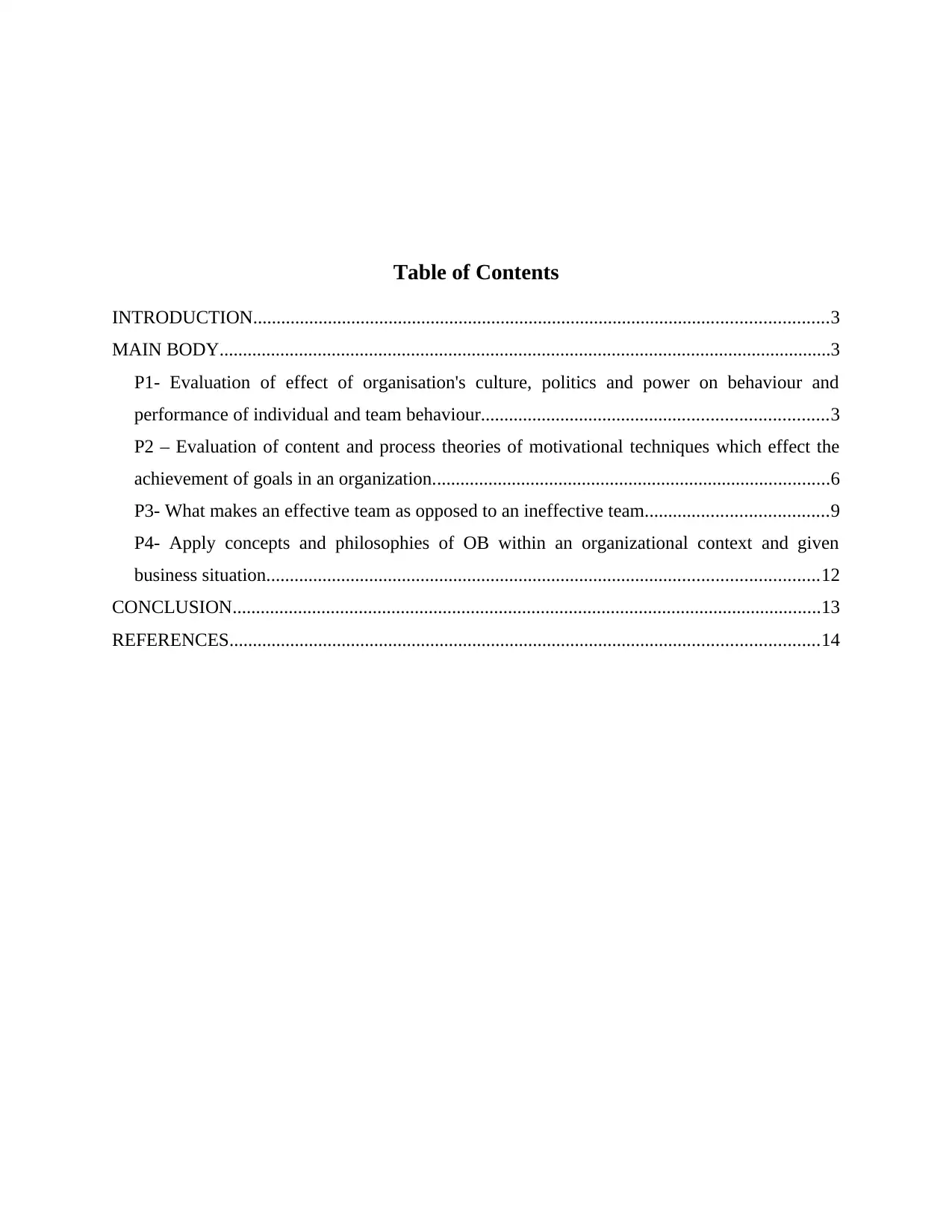
Table of Contents
INTRODUCTION...........................................................................................................................3
MAIN BODY...................................................................................................................................3
P1- Evaluation of effect of organisation's culture, politics and power on behaviour and
performance of individual and team behaviour..........................................................................3
P2 – Evaluation of content and process theories of motivational techniques which effect the
achievement of goals in an organization.....................................................................................6
P3- What makes an effective team as opposed to an ineffective team.......................................9
P4- Apply concepts and philosophies of OB within an organizational context and given
business situation......................................................................................................................12
CONCLUSION..............................................................................................................................13
REFERENCES..............................................................................................................................14
INTRODUCTION...........................................................................................................................3
MAIN BODY...................................................................................................................................3
P1- Evaluation of effect of organisation's culture, politics and power on behaviour and
performance of individual and team behaviour..........................................................................3
P2 – Evaluation of content and process theories of motivational techniques which effect the
achievement of goals in an organization.....................................................................................6
P3- What makes an effective team as opposed to an ineffective team.......................................9
P4- Apply concepts and philosophies of OB within an organizational context and given
business situation......................................................................................................................12
CONCLUSION..............................................................................................................................13
REFERENCES..............................................................................................................................14
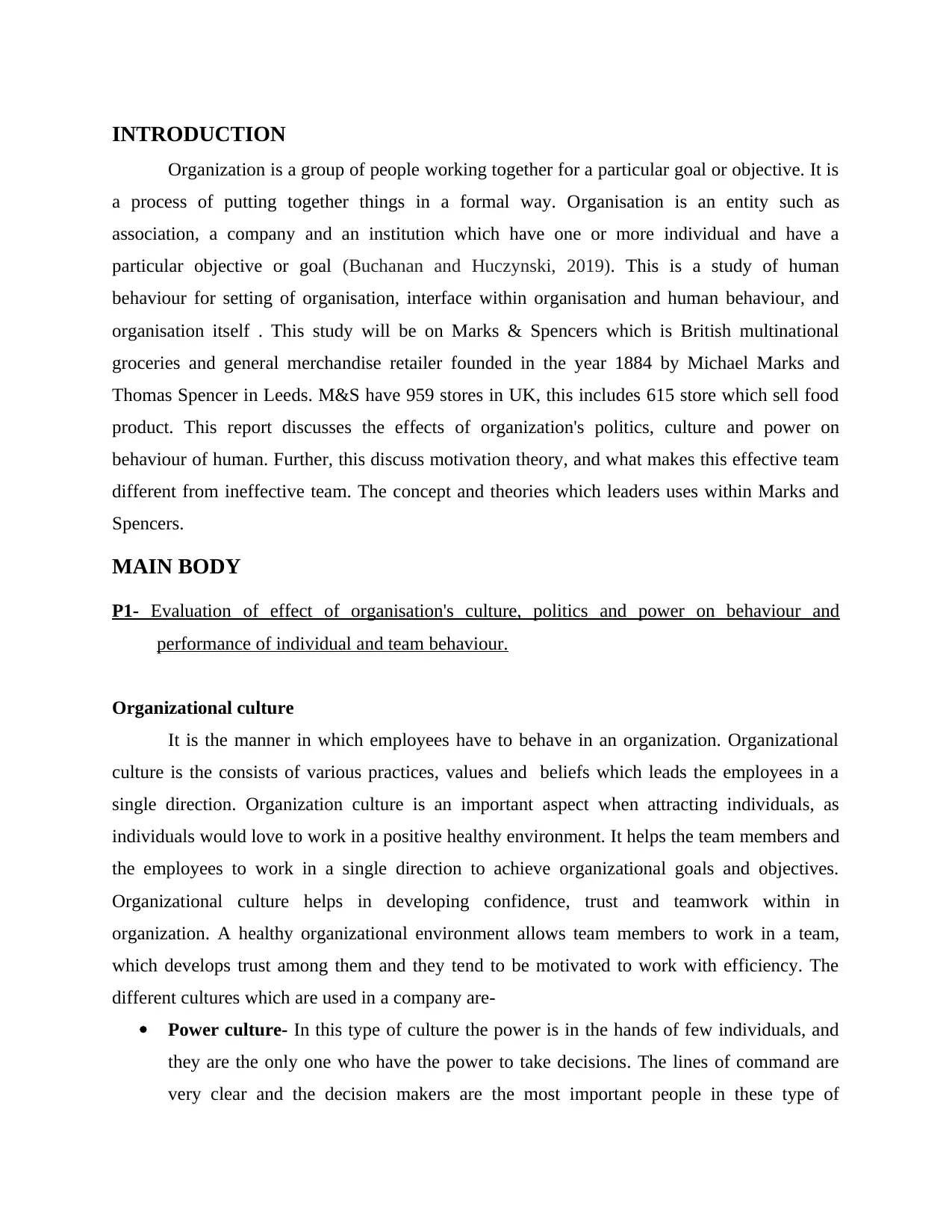
INTRODUCTION
Organization is a group of people working together for a particular goal or objective. It is
a process of putting together things in a formal way. Organisation is an entity such as
association, a company and an institution which have one or more individual and have a
particular objective or goal (Buchanan and Huczynski, 2019). This is a study of human
behaviour for setting of organisation, interface within organisation and human behaviour, and
organisation itself . This study will be on Marks & Spencers which is British multinational
groceries and general merchandise retailer founded in the year 1884 by Michael Marks and
Thomas Spencer in Leeds. M&S have 959 stores in UK, this includes 615 store which sell food
product. This report discusses the effects of organization's politics, culture and power on
behaviour of human. Further, this discuss motivation theory, and what makes this effective team
different from ineffective team. The concept and theories which leaders uses within Marks and
Spencers.
MAIN BODY
P1- Evaluation of effect of organisation's culture, politics and power on behaviour and
performance of individual and team behaviour.
Organizational culture
It is the manner in which employees have to behave in an organization. Organizational
culture is the consists of various practices, values and beliefs which leads the employees in a
single direction. Organization culture is an important aspect when attracting individuals, as
individuals would love to work in a positive healthy environment. It helps the team members and
the employees to work in a single direction to achieve organizational goals and objectives.
Organizational culture helps in developing confidence, trust and teamwork within in
organization. A healthy organizational environment allows team members to work in a team,
which develops trust among them and they tend to be motivated to work with efficiency. The
different cultures which are used in a company are-
Power culture- In this type of culture the power is in the hands of few individuals, and
they are the only one who have the power to take decisions. The lines of command are
very clear and the decision makers are the most important people in these type of
Organization is a group of people working together for a particular goal or objective. It is
a process of putting together things in a formal way. Organisation is an entity such as
association, a company and an institution which have one or more individual and have a
particular objective or goal (Buchanan and Huczynski, 2019). This is a study of human
behaviour for setting of organisation, interface within organisation and human behaviour, and
organisation itself . This study will be on Marks & Spencers which is British multinational
groceries and general merchandise retailer founded in the year 1884 by Michael Marks and
Thomas Spencer in Leeds. M&S have 959 stores in UK, this includes 615 store which sell food
product. This report discusses the effects of organization's politics, culture and power on
behaviour of human. Further, this discuss motivation theory, and what makes this effective team
different from ineffective team. The concept and theories which leaders uses within Marks and
Spencers.
MAIN BODY
P1- Evaluation of effect of organisation's culture, politics and power on behaviour and
performance of individual and team behaviour.
Organizational culture
It is the manner in which employees have to behave in an organization. Organizational
culture is the consists of various practices, values and beliefs which leads the employees in a
single direction. Organization culture is an important aspect when attracting individuals, as
individuals would love to work in a positive healthy environment. It helps the team members and
the employees to work in a single direction to achieve organizational goals and objectives.
Organizational culture helps in developing confidence, trust and teamwork within in
organization. A healthy organizational environment allows team members to work in a team,
which develops trust among them and they tend to be motivated to work with efficiency. The
different cultures which are used in a company are-
Power culture- In this type of culture the power is in the hands of few individuals, and
they are the only one who have the power to take decisions. The lines of command are
very clear and the decision makers are the most important people in these type of
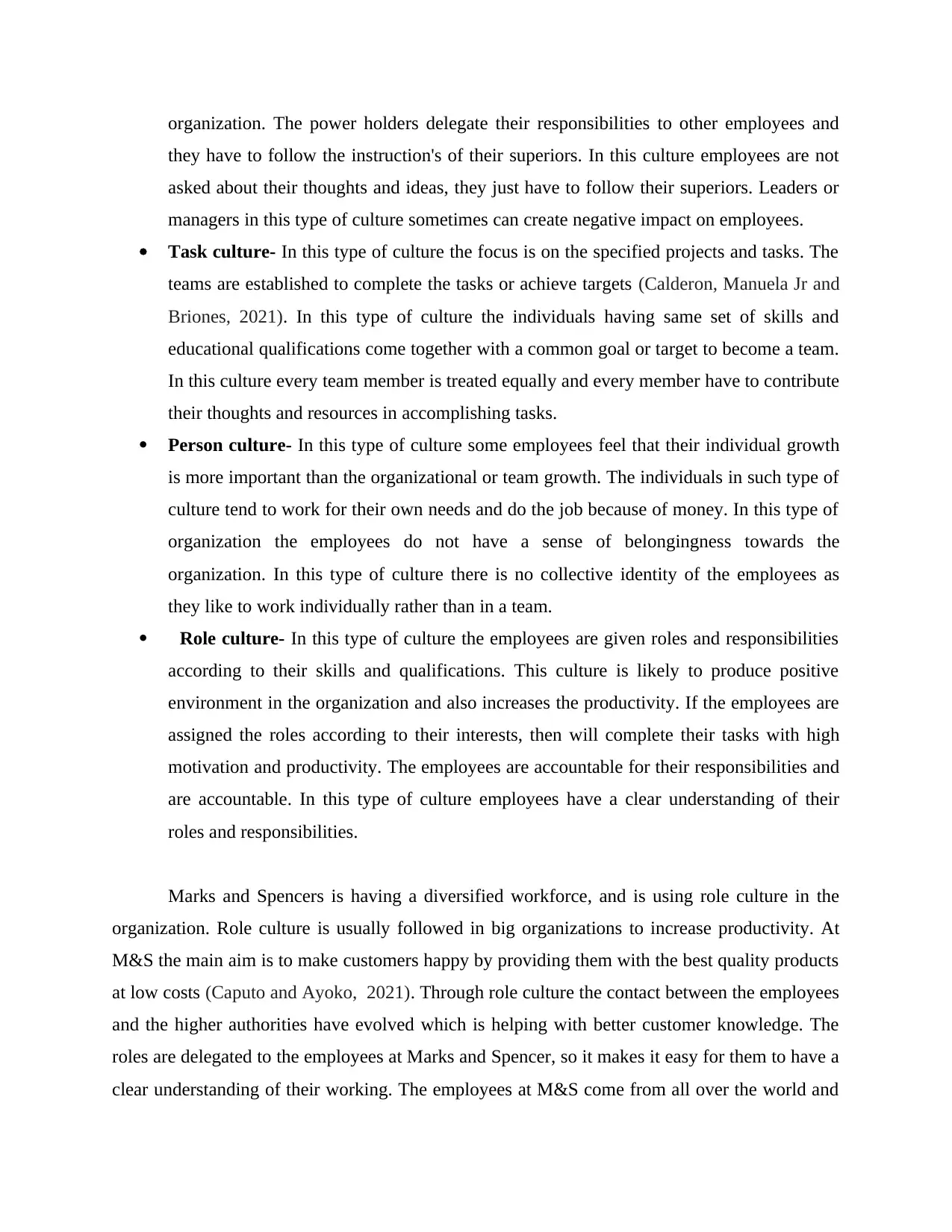
organization. The power holders delegate their responsibilities to other employees and
they have to follow the instruction's of their superiors. In this culture employees are not
asked about their thoughts and ideas, they just have to follow their superiors. Leaders or
managers in this type of culture sometimes can create negative impact on employees.
Task culture- In this type of culture the focus is on the specified projects and tasks. The
teams are established to complete the tasks or achieve targets (Calderon, Manuela Jr and
Briones, 2021). In this type of culture the individuals having same set of skills and
educational qualifications come together with a common goal or target to become a team.
In this culture every team member is treated equally and every member have to contribute
their thoughts and resources in accomplishing tasks.
Person culture- In this type of culture some employees feel that their individual growth
is more important than the organizational or team growth. The individuals in such type of
culture tend to work for their own needs and do the job because of money. In this type of
organization the employees do not have a sense of belongingness towards the
organization. In this type of culture there is no collective identity of the employees as
they like to work individually rather than in a team.
Role culture- In this type of culture the employees are given roles and responsibilities
according to their skills and qualifications. This culture is likely to produce positive
environment in the organization and also increases the productivity. If the employees are
assigned the roles according to their interests, then will complete their tasks with high
motivation and productivity. The employees are accountable for their responsibilities and
are accountable. In this type of culture employees have a clear understanding of their
roles and responsibilities.
Marks and Spencers is having a diversified workforce, and is using role culture in the
organization. Role culture is usually followed in big organizations to increase productivity. At
M&S the main aim is to make customers happy by providing them with the best quality products
at low costs (Caputo and Ayoko, 2021). Through role culture the contact between the employees
and the higher authorities have evolved which is helping with better customer knowledge. The
roles are delegated to the employees at Marks and Spencer, so it makes it easy for them to have a
clear understanding of their working. The employees at M&S come from all over the world and
they have to follow the instruction's of their superiors. In this culture employees are not
asked about their thoughts and ideas, they just have to follow their superiors. Leaders or
managers in this type of culture sometimes can create negative impact on employees.
Task culture- In this type of culture the focus is on the specified projects and tasks. The
teams are established to complete the tasks or achieve targets (Calderon, Manuela Jr and
Briones, 2021). In this type of culture the individuals having same set of skills and
educational qualifications come together with a common goal or target to become a team.
In this culture every team member is treated equally and every member have to contribute
their thoughts and resources in accomplishing tasks.
Person culture- In this type of culture some employees feel that their individual growth
is more important than the organizational or team growth. The individuals in such type of
culture tend to work for their own needs and do the job because of money. In this type of
organization the employees do not have a sense of belongingness towards the
organization. In this type of culture there is no collective identity of the employees as
they like to work individually rather than in a team.
Role culture- In this type of culture the employees are given roles and responsibilities
according to their skills and qualifications. This culture is likely to produce positive
environment in the organization and also increases the productivity. If the employees are
assigned the roles according to their interests, then will complete their tasks with high
motivation and productivity. The employees are accountable for their responsibilities and
are accountable. In this type of culture employees have a clear understanding of their
roles and responsibilities.
Marks and Spencers is having a diversified workforce, and is using role culture in the
organization. Role culture is usually followed in big organizations to increase productivity. At
M&S the main aim is to make customers happy by providing them with the best quality products
at low costs (Caputo and Ayoko, 2021). Through role culture the contact between the employees
and the higher authorities have evolved which is helping with better customer knowledge. The
roles are delegated to the employees at Marks and Spencer, so it makes it easy for them to have a
clear understanding of their working. The employees at M&S come from all over the world and
Secure Best Marks with AI Grader
Need help grading? Try our AI Grader for instant feedback on your assignments.
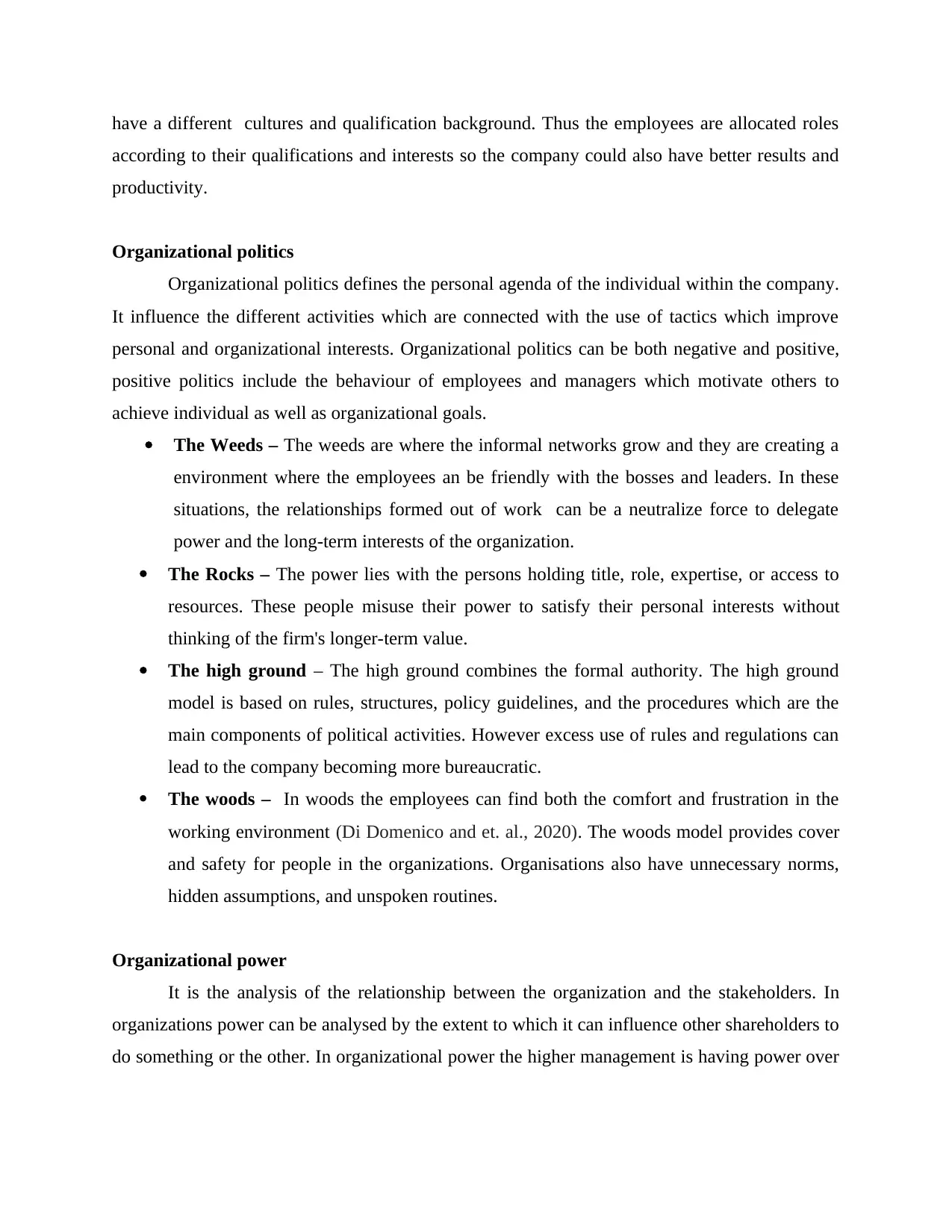
have a different cultures and qualification background. Thus the employees are allocated roles
according to their qualifications and interests so the company could also have better results and
productivity.
Organizational politics
Organizational politics defines the personal agenda of the individual within the company.
It influence the different activities which are connected with the use of tactics which improve
personal and organizational interests. Organizational politics can be both negative and positive,
positive politics include the behaviour of employees and managers which motivate others to
achieve individual as well as organizational goals.
The Weeds – The weeds are where the informal networks grow and they are creating a
environment where the employees an be friendly with the bosses and leaders. In these
situations, the relationships formed out of work can be a neutralize force to delegate
power and the long-term interests of the organization.
The Rocks – The power lies with the persons holding title, role, expertise, or access to
resources. These people misuse their power to satisfy their personal interests without
thinking of the firm's longer-term value.
The high ground – The high ground combines the formal authority. The high ground
model is based on rules, structures, policy guidelines, and the procedures which are the
main components of political activities. However excess use of rules and regulations can
lead to the company becoming more bureaucratic.
The woods – In woods the employees can find both the comfort and frustration in the
working environment (Di Domenico and et. al., 2020). The woods model provides cover
and safety for people in the organizations. Organisations also have unnecessary norms,
hidden assumptions, and unspoken routines.
Organizational power
It is the analysis of the relationship between the organization and the stakeholders. In
organizations power can be analysed by the extent to which it can influence other shareholders to
do something or the other. In organizational power the higher management is having power over
according to their qualifications and interests so the company could also have better results and
productivity.
Organizational politics
Organizational politics defines the personal agenda of the individual within the company.
It influence the different activities which are connected with the use of tactics which improve
personal and organizational interests. Organizational politics can be both negative and positive,
positive politics include the behaviour of employees and managers which motivate others to
achieve individual as well as organizational goals.
The Weeds – The weeds are where the informal networks grow and they are creating a
environment where the employees an be friendly with the bosses and leaders. In these
situations, the relationships formed out of work can be a neutralize force to delegate
power and the long-term interests of the organization.
The Rocks – The power lies with the persons holding title, role, expertise, or access to
resources. These people misuse their power to satisfy their personal interests without
thinking of the firm's longer-term value.
The high ground – The high ground combines the formal authority. The high ground
model is based on rules, structures, policy guidelines, and the procedures which are the
main components of political activities. However excess use of rules and regulations can
lead to the company becoming more bureaucratic.
The woods – In woods the employees can find both the comfort and frustration in the
working environment (Di Domenico and et. al., 2020). The woods model provides cover
and safety for people in the organizations. Organisations also have unnecessary norms,
hidden assumptions, and unspoken routines.
Organizational power
It is the analysis of the relationship between the organization and the stakeholders. In
organizations power can be analysed by the extent to which it can influence other shareholders to
do something or the other. In organizational power the higher management is having power over
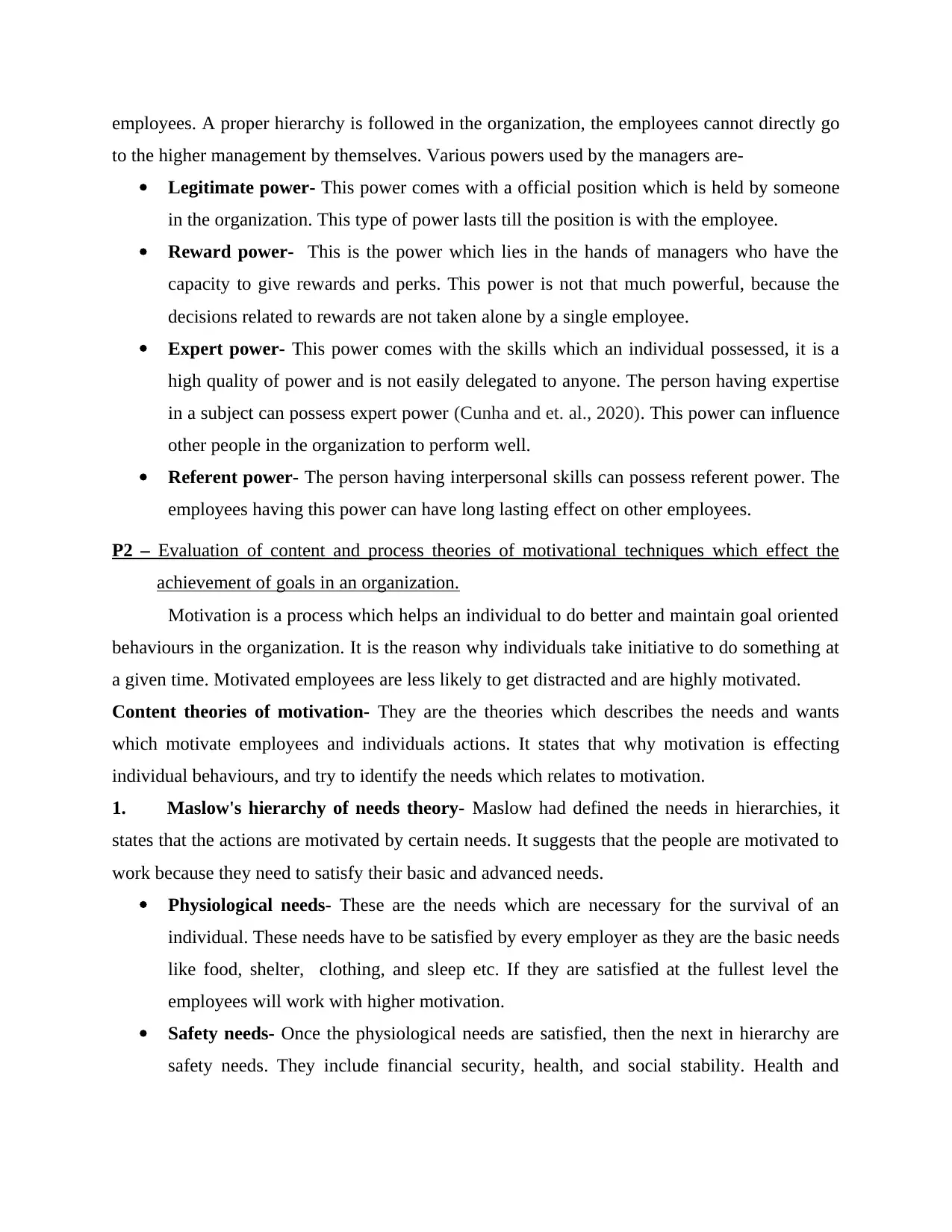
employees. A proper hierarchy is followed in the organization, the employees cannot directly go
to the higher management by themselves. Various powers used by the managers are-
Legitimate power- This power comes with a official position which is held by someone
in the organization. This type of power lasts till the position is with the employee.
Reward power- This is the power which lies in the hands of managers who have the
capacity to give rewards and perks. This power is not that much powerful, because the
decisions related to rewards are not taken alone by a single employee.
Expert power- This power comes with the skills which an individual possessed, it is a
high quality of power and is not easily delegated to anyone. The person having expertise
in a subject can possess expert power (Cunha and et. al., 2020). This power can influence
other people in the organization to perform well.
Referent power- The person having interpersonal skills can possess referent power. The
employees having this power can have long lasting effect on other employees.
P2 – Evaluation of content and process theories of motivational techniques which effect the
achievement of goals in an organization.
Motivation is a process which helps an individual to do better and maintain goal oriented
behaviours in the organization. It is the reason why individuals take initiative to do something at
a given time. Motivated employees are less likely to get distracted and are highly motivated.
Content theories of motivation- They are the theories which describes the needs and wants
which motivate employees and individuals actions. It states that why motivation is effecting
individual behaviours, and try to identify the needs which relates to motivation.
1. Maslow's hierarchy of needs theory- Maslow had defined the needs in hierarchies, it
states that the actions are motivated by certain needs. It suggests that the people are motivated to
work because they need to satisfy their basic and advanced needs.
Physiological needs- These are the needs which are necessary for the survival of an
individual. These needs have to be satisfied by every employer as they are the basic needs
like food, shelter, clothing, and sleep etc. If they are satisfied at the fullest level the
employees will work with higher motivation.
Safety needs- Once the physiological needs are satisfied, then the next in hierarchy are
safety needs. They include financial security, health, and social stability. Health and
to the higher management by themselves. Various powers used by the managers are-
Legitimate power- This power comes with a official position which is held by someone
in the organization. This type of power lasts till the position is with the employee.
Reward power- This is the power which lies in the hands of managers who have the
capacity to give rewards and perks. This power is not that much powerful, because the
decisions related to rewards are not taken alone by a single employee.
Expert power- This power comes with the skills which an individual possessed, it is a
high quality of power and is not easily delegated to anyone. The person having expertise
in a subject can possess expert power (Cunha and et. al., 2020). This power can influence
other people in the organization to perform well.
Referent power- The person having interpersonal skills can possess referent power. The
employees having this power can have long lasting effect on other employees.
P2 – Evaluation of content and process theories of motivational techniques which effect the
achievement of goals in an organization.
Motivation is a process which helps an individual to do better and maintain goal oriented
behaviours in the organization. It is the reason why individuals take initiative to do something at
a given time. Motivated employees are less likely to get distracted and are highly motivated.
Content theories of motivation- They are the theories which describes the needs and wants
which motivate employees and individuals actions. It states that why motivation is effecting
individual behaviours, and try to identify the needs which relates to motivation.
1. Maslow's hierarchy of needs theory- Maslow had defined the needs in hierarchies, it
states that the actions are motivated by certain needs. It suggests that the people are motivated to
work because they need to satisfy their basic and advanced needs.
Physiological needs- These are the needs which are necessary for the survival of an
individual. These needs have to be satisfied by every employer as they are the basic needs
like food, shelter, clothing, and sleep etc. If they are satisfied at the fullest level the
employees will work with higher motivation.
Safety needs- Once the physiological needs are satisfied, then the next in hierarchy are
safety needs. They include financial security, health, and social stability. Health and
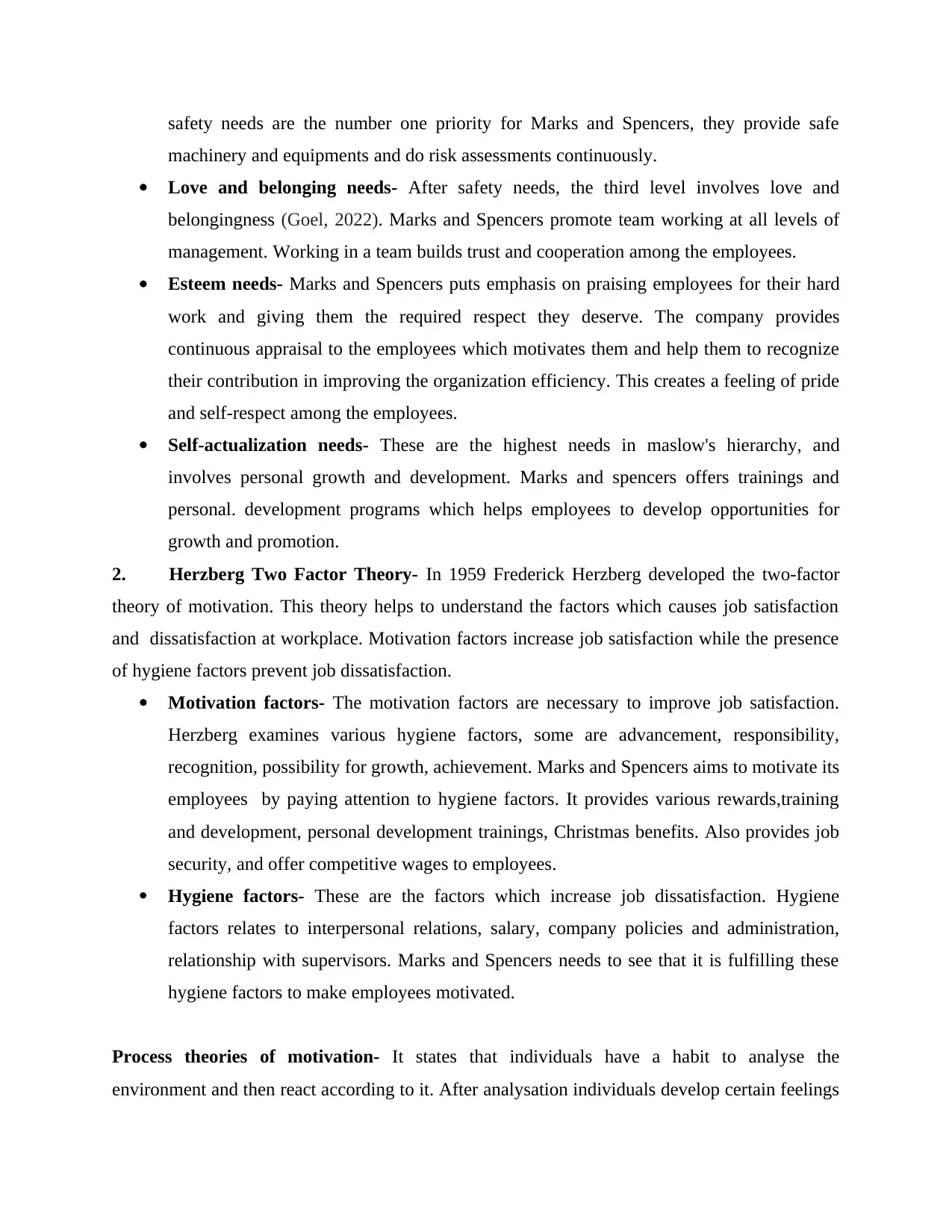
safety needs are the number one priority for Marks and Spencers, they provide safe
machinery and equipments and do risk assessments continuously.
Love and belonging needs- After safety needs, the third level involves love and
belongingness (Goel, 2022). Marks and Spencers promote team working at all levels of
management. Working in a team builds trust and cooperation among the employees.
Esteem needs- Marks and Spencers puts emphasis on praising employees for their hard
work and giving them the required respect they deserve. The company provides
continuous appraisal to the employees which motivates them and help them to recognize
their contribution in improving the organization efficiency. This creates a feeling of pride
and self-respect among the employees.
Self-actualization needs- These are the highest needs in maslow's hierarchy, and
involves personal growth and development. Marks and spencers offers trainings and
personal. development programs which helps employees to develop opportunities for
growth and promotion.
2. Herzberg Two Factor Theory- In 1959 Frederick Herzberg developed the two-factor
theory of motivation. This theory helps to understand the factors which causes job satisfaction
and dissatisfaction at workplace. Motivation factors increase job satisfaction while the presence
of hygiene factors prevent job dissatisfaction.
Motivation factors- The motivation factors are necessary to improve job satisfaction.
Herzberg examines various hygiene factors, some are advancement, responsibility,
recognition, possibility for growth, achievement. Marks and Spencers aims to motivate its
employees by paying attention to hygiene factors. It provides various rewards,training
and development, personal development trainings, Christmas benefits. Also provides job
security, and offer competitive wages to employees.
Hygiene factors- These are the factors which increase job dissatisfaction. Hygiene
factors relates to interpersonal relations, salary, company policies and administration,
relationship with supervisors. Marks and Spencers needs to see that it is fulfilling these
hygiene factors to make employees motivated.
Process theories of motivation- It states that individuals have a habit to analyse the
environment and then react according to it. After analysation individuals develop certain feelings
machinery and equipments and do risk assessments continuously.
Love and belonging needs- After safety needs, the third level involves love and
belongingness (Goel, 2022). Marks and Spencers promote team working at all levels of
management. Working in a team builds trust and cooperation among the employees.
Esteem needs- Marks and Spencers puts emphasis on praising employees for their hard
work and giving them the required respect they deserve. The company provides
continuous appraisal to the employees which motivates them and help them to recognize
their contribution in improving the organization efficiency. This creates a feeling of pride
and self-respect among the employees.
Self-actualization needs- These are the highest needs in maslow's hierarchy, and
involves personal growth and development. Marks and spencers offers trainings and
personal. development programs which helps employees to develop opportunities for
growth and promotion.
2. Herzberg Two Factor Theory- In 1959 Frederick Herzberg developed the two-factor
theory of motivation. This theory helps to understand the factors which causes job satisfaction
and dissatisfaction at workplace. Motivation factors increase job satisfaction while the presence
of hygiene factors prevent job dissatisfaction.
Motivation factors- The motivation factors are necessary to improve job satisfaction.
Herzberg examines various hygiene factors, some are advancement, responsibility,
recognition, possibility for growth, achievement. Marks and Spencers aims to motivate its
employees by paying attention to hygiene factors. It provides various rewards,training
and development, personal development trainings, Christmas benefits. Also provides job
security, and offer competitive wages to employees.
Hygiene factors- These are the factors which increase job dissatisfaction. Hygiene
factors relates to interpersonal relations, salary, company policies and administration,
relationship with supervisors. Marks and Spencers needs to see that it is fulfilling these
hygiene factors to make employees motivated.
Process theories of motivation- It states that individuals have a habit to analyse the
environment and then react according to it. After analysation individuals develop certain feelings
Paraphrase This Document
Need a fresh take? Get an instant paraphrase of this document with our AI Paraphraser
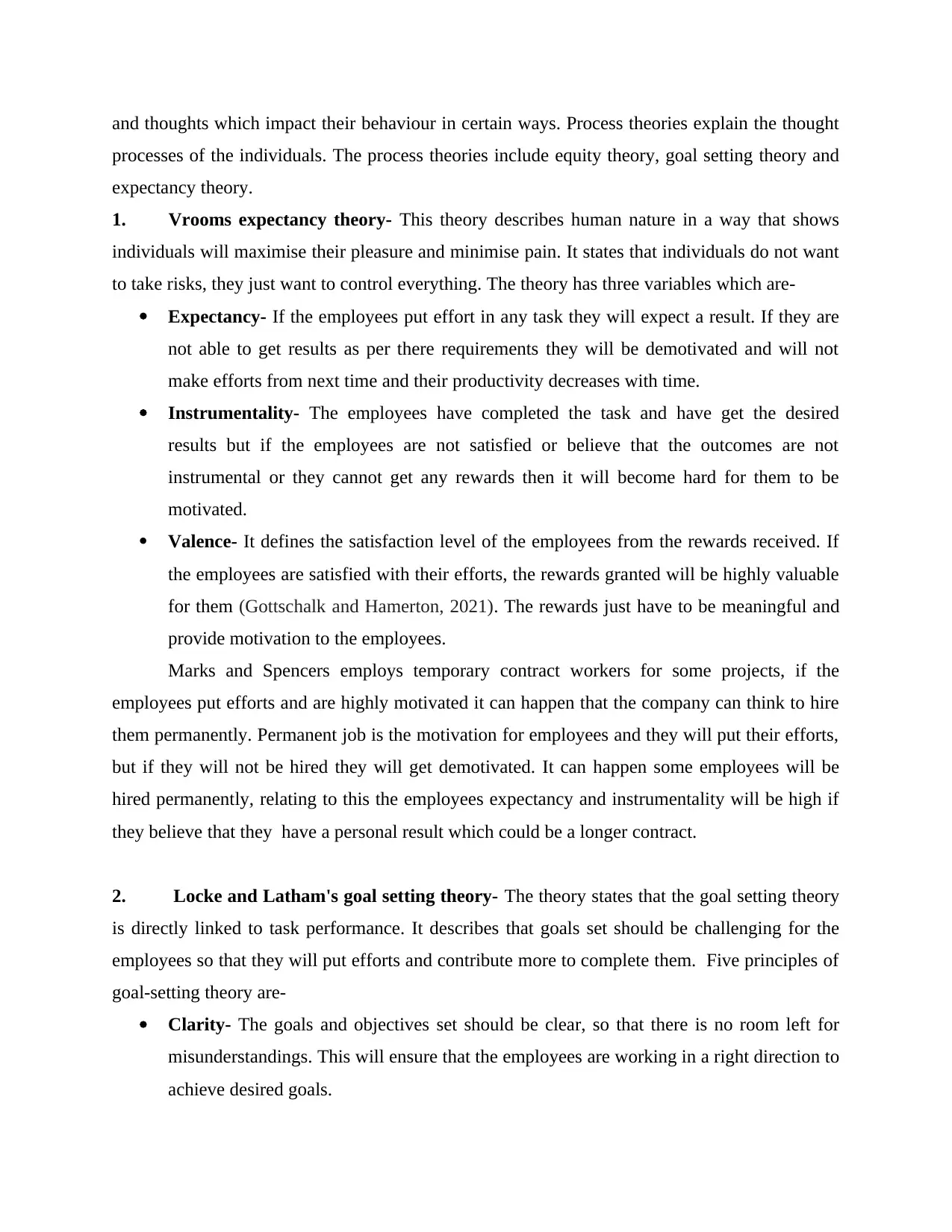
and thoughts which impact their behaviour in certain ways. Process theories explain the thought
processes of the individuals. The process theories include equity theory, goal setting theory and
expectancy theory.
1. Vrooms expectancy theory- This theory describes human nature in a way that shows
individuals will maximise their pleasure and minimise pain. It states that individuals do not want
to take risks, they just want to control everything. The theory has three variables which are-
Expectancy- If the employees put effort in any task they will expect a result. If they are
not able to get results as per there requirements they will be demotivated and will not
make efforts from next time and their productivity decreases with time.
Instrumentality- The employees have completed the task and have get the desired
results but if the employees are not satisfied or believe that the outcomes are not
instrumental or they cannot get any rewards then it will become hard for them to be
motivated.
Valence- It defines the satisfaction level of the employees from the rewards received. If
the employees are satisfied with their efforts, the rewards granted will be highly valuable
for them (Gottschalk and Hamerton, 2021). The rewards just have to be meaningful and
provide motivation to the employees.
Marks and Spencers employs temporary contract workers for some projects, if the
employees put efforts and are highly motivated it can happen that the company can think to hire
them permanently. Permanent job is the motivation for employees and they will put their efforts,
but if they will not be hired they will get demotivated. It can happen some employees will be
hired permanently, relating to this the employees expectancy and instrumentality will be high if
they believe that they have a personal result which could be a longer contract.
2. Locke and Latham's goal setting theory- The theory states that the goal setting theory
is directly linked to task performance. It describes that goals set should be challenging for the
employees so that they will put efforts and contribute more to complete them. Five principles of
goal-setting theory are-
Clarity- The goals and objectives set should be clear, so that there is no room left for
misunderstandings. This will ensure that the employees are working in a right direction to
achieve desired goals.
processes of the individuals. The process theories include equity theory, goal setting theory and
expectancy theory.
1. Vrooms expectancy theory- This theory describes human nature in a way that shows
individuals will maximise their pleasure and minimise pain. It states that individuals do not want
to take risks, they just want to control everything. The theory has three variables which are-
Expectancy- If the employees put effort in any task they will expect a result. If they are
not able to get results as per there requirements they will be demotivated and will not
make efforts from next time and their productivity decreases with time.
Instrumentality- The employees have completed the task and have get the desired
results but if the employees are not satisfied or believe that the outcomes are not
instrumental or they cannot get any rewards then it will become hard for them to be
motivated.
Valence- It defines the satisfaction level of the employees from the rewards received. If
the employees are satisfied with their efforts, the rewards granted will be highly valuable
for them (Gottschalk and Hamerton, 2021). The rewards just have to be meaningful and
provide motivation to the employees.
Marks and Spencers employs temporary contract workers for some projects, if the
employees put efforts and are highly motivated it can happen that the company can think to hire
them permanently. Permanent job is the motivation for employees and they will put their efforts,
but if they will not be hired they will get demotivated. It can happen some employees will be
hired permanently, relating to this the employees expectancy and instrumentality will be high if
they believe that they have a personal result which could be a longer contract.
2. Locke and Latham's goal setting theory- The theory states that the goal setting theory
is directly linked to task performance. It describes that goals set should be challenging for the
employees so that they will put efforts and contribute more to complete them. Five principles of
goal-setting theory are-
Clarity- The goals and objectives set should be clear, so that there is no room left for
misunderstandings. This will ensure that the employees are working in a right direction to
achieve desired goals.
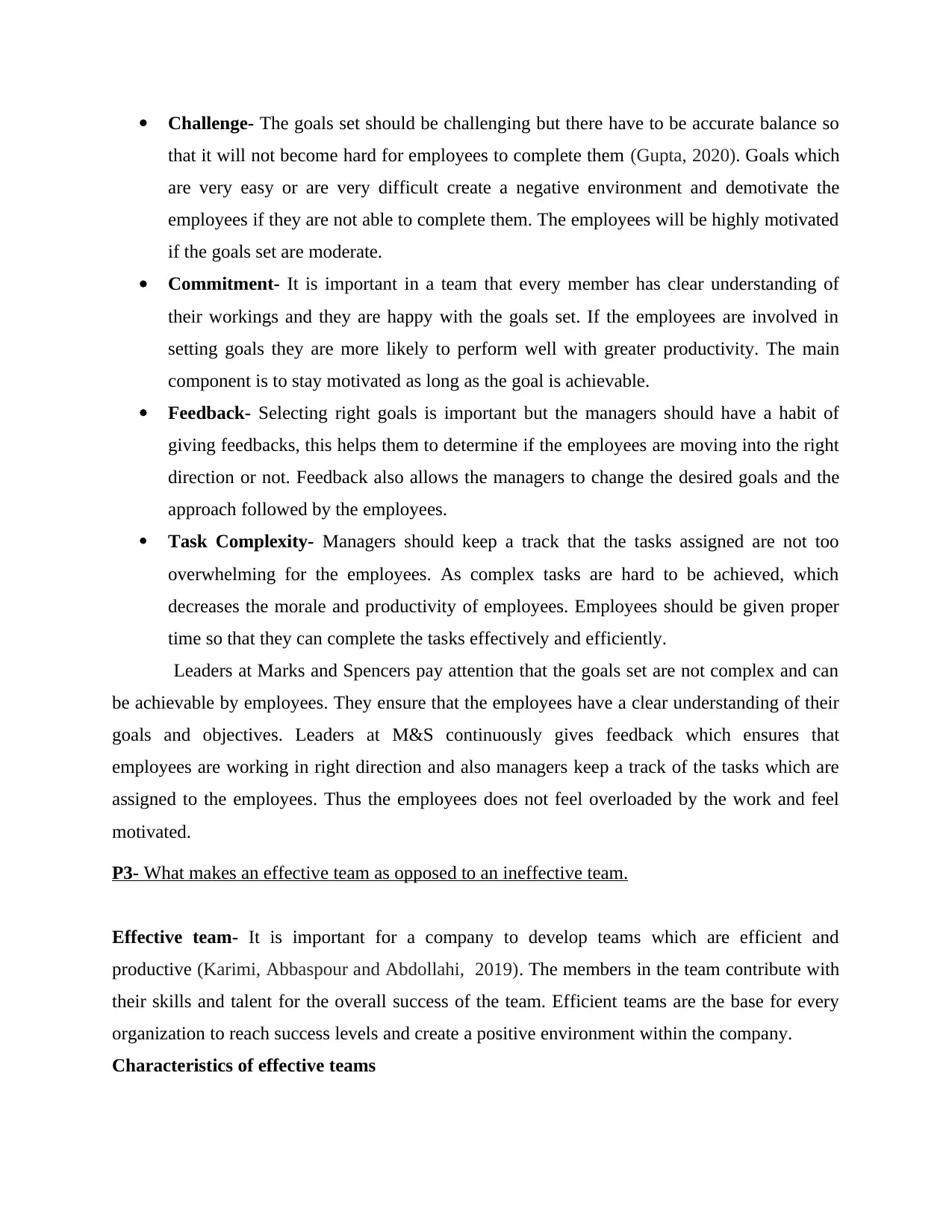
Challenge- The goals set should be challenging but there have to be accurate balance so
that it will not become hard for employees to complete them (Gupta, 2020). Goals which
are very easy or are very difficult create a negative environment and demotivate the
employees if they are not able to complete them. The employees will be highly motivated
if the goals set are moderate.
Commitment- It is important in a team that every member has clear understanding of
their workings and they are happy with the goals set. If the employees are involved in
setting goals they are more likely to perform well with greater productivity. The main
component is to stay motivated as long as the goal is achievable.
Feedback- Selecting right goals is important but the managers should have a habit of
giving feedbacks, this helps them to determine if the employees are moving into the right
direction or not. Feedback also allows the managers to change the desired goals and the
approach followed by the employees.
Task Complexity- Managers should keep a track that the tasks assigned are not too
overwhelming for the employees. As complex tasks are hard to be achieved, which
decreases the morale and productivity of employees. Employees should be given proper
time so that they can complete the tasks effectively and efficiently.
Leaders at Marks and Spencers pay attention that the goals set are not complex and can
be achievable by employees. They ensure that the employees have a clear understanding of their
goals and objectives. Leaders at M&S continuously gives feedback which ensures that
employees are working in right direction and also managers keep a track of the tasks which are
assigned to the employees. Thus the employees does not feel overloaded by the work and feel
motivated.
P3- What makes an effective team as opposed to an ineffective team.
Effective team- It is important for a company to develop teams which are efficient and
productive (Karimi, Abbaspour and Abdollahi, 2019). The members in the team contribute with
their skills and talent for the overall success of the team. Efficient teams are the base for every
organization to reach success levels and create a positive environment within the company.
Characteristics of effective teams
that it will not become hard for employees to complete them (Gupta, 2020). Goals which
are very easy or are very difficult create a negative environment and demotivate the
employees if they are not able to complete them. The employees will be highly motivated
if the goals set are moderate.
Commitment- It is important in a team that every member has clear understanding of
their workings and they are happy with the goals set. If the employees are involved in
setting goals they are more likely to perform well with greater productivity. The main
component is to stay motivated as long as the goal is achievable.
Feedback- Selecting right goals is important but the managers should have a habit of
giving feedbacks, this helps them to determine if the employees are moving into the right
direction or not. Feedback also allows the managers to change the desired goals and the
approach followed by the employees.
Task Complexity- Managers should keep a track that the tasks assigned are not too
overwhelming for the employees. As complex tasks are hard to be achieved, which
decreases the morale and productivity of employees. Employees should be given proper
time so that they can complete the tasks effectively and efficiently.
Leaders at Marks and Spencers pay attention that the goals set are not complex and can
be achievable by employees. They ensure that the employees have a clear understanding of their
goals and objectives. Leaders at M&S continuously gives feedback which ensures that
employees are working in right direction and also managers keep a track of the tasks which are
assigned to the employees. Thus the employees does not feel overloaded by the work and feel
motivated.
P3- What makes an effective team as opposed to an ineffective team.
Effective team- It is important for a company to develop teams which are efficient and
productive (Karimi, Abbaspour and Abdollahi, 2019). The members in the team contribute with
their skills and talent for the overall success of the team. Efficient teams are the base for every
organization to reach success levels and create a positive environment within the company.
Characteristics of effective teams
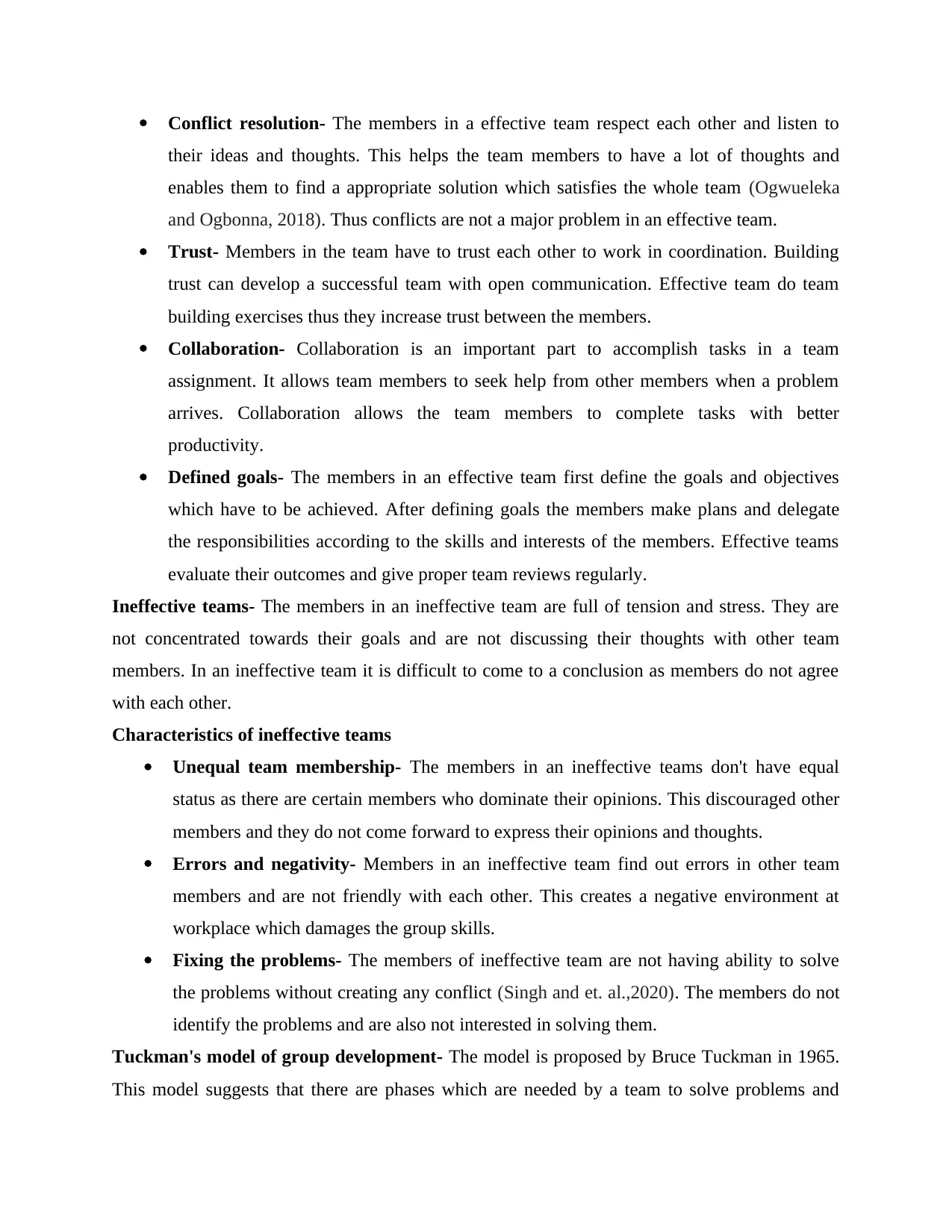
Conflict resolution- The members in a effective team respect each other and listen to
their ideas and thoughts. This helps the team members to have a lot of thoughts and
enables them to find a appropriate solution which satisfies the whole team (Ogwueleka
and Ogbonna, 2018). Thus conflicts are not a major problem in an effective team.
Trust- Members in the team have to trust each other to work in coordination. Building
trust can develop a successful team with open communication. Effective team do team
building exercises thus they increase trust between the members.
Collaboration- Collaboration is an important part to accomplish tasks in a team
assignment. It allows team members to seek help from other members when a problem
arrives. Collaboration allows the team members to complete tasks with better
productivity.
Defined goals- The members in an effective team first define the goals and objectives
which have to be achieved. After defining goals the members make plans and delegate
the responsibilities according to the skills and interests of the members. Effective teams
evaluate their outcomes and give proper team reviews regularly.
Ineffective teams- The members in an ineffective team are full of tension and stress. They are
not concentrated towards their goals and are not discussing their thoughts with other team
members. In an ineffective team it is difficult to come to a conclusion as members do not agree
with each other.
Characteristics of ineffective teams
Unequal team membership- The members in an ineffective teams don't have equal
status as there are certain members who dominate their opinions. This discouraged other
members and they do not come forward to express their opinions and thoughts.
Errors and negativity- Members in an ineffective team find out errors in other team
members and are not friendly with each other. This creates a negative environment at
workplace which damages the group skills.
Fixing the problems- The members of ineffective team are not having ability to solve
the problems without creating any conflict (Singh and et. al.,2020). The members do not
identify the problems and are also not interested in solving them.
Tuckman's model of group development- The model is proposed by Bruce Tuckman in 1965.
This model suggests that there are phases which are needed by a team to solve problems and
their ideas and thoughts. This helps the team members to have a lot of thoughts and
enables them to find a appropriate solution which satisfies the whole team (Ogwueleka
and Ogbonna, 2018). Thus conflicts are not a major problem in an effective team.
Trust- Members in the team have to trust each other to work in coordination. Building
trust can develop a successful team with open communication. Effective team do team
building exercises thus they increase trust between the members.
Collaboration- Collaboration is an important part to accomplish tasks in a team
assignment. It allows team members to seek help from other members when a problem
arrives. Collaboration allows the team members to complete tasks with better
productivity.
Defined goals- The members in an effective team first define the goals and objectives
which have to be achieved. After defining goals the members make plans and delegate
the responsibilities according to the skills and interests of the members. Effective teams
evaluate their outcomes and give proper team reviews regularly.
Ineffective teams- The members in an ineffective team are full of tension and stress. They are
not concentrated towards their goals and are not discussing their thoughts with other team
members. In an ineffective team it is difficult to come to a conclusion as members do not agree
with each other.
Characteristics of ineffective teams
Unequal team membership- The members in an ineffective teams don't have equal
status as there are certain members who dominate their opinions. This discouraged other
members and they do not come forward to express their opinions and thoughts.
Errors and negativity- Members in an ineffective team find out errors in other team
members and are not friendly with each other. This creates a negative environment at
workplace which damages the group skills.
Fixing the problems- The members of ineffective team are not having ability to solve
the problems without creating any conflict (Singh and et. al.,2020). The members do not
identify the problems and are also not interested in solving them.
Tuckman's model of group development- The model is proposed by Bruce Tuckman in 1965.
This model suggests that there are phases which are needed by a team to solve problems and
Secure Best Marks with AI Grader
Need help grading? Try our AI Grader for instant feedback on your assignments.
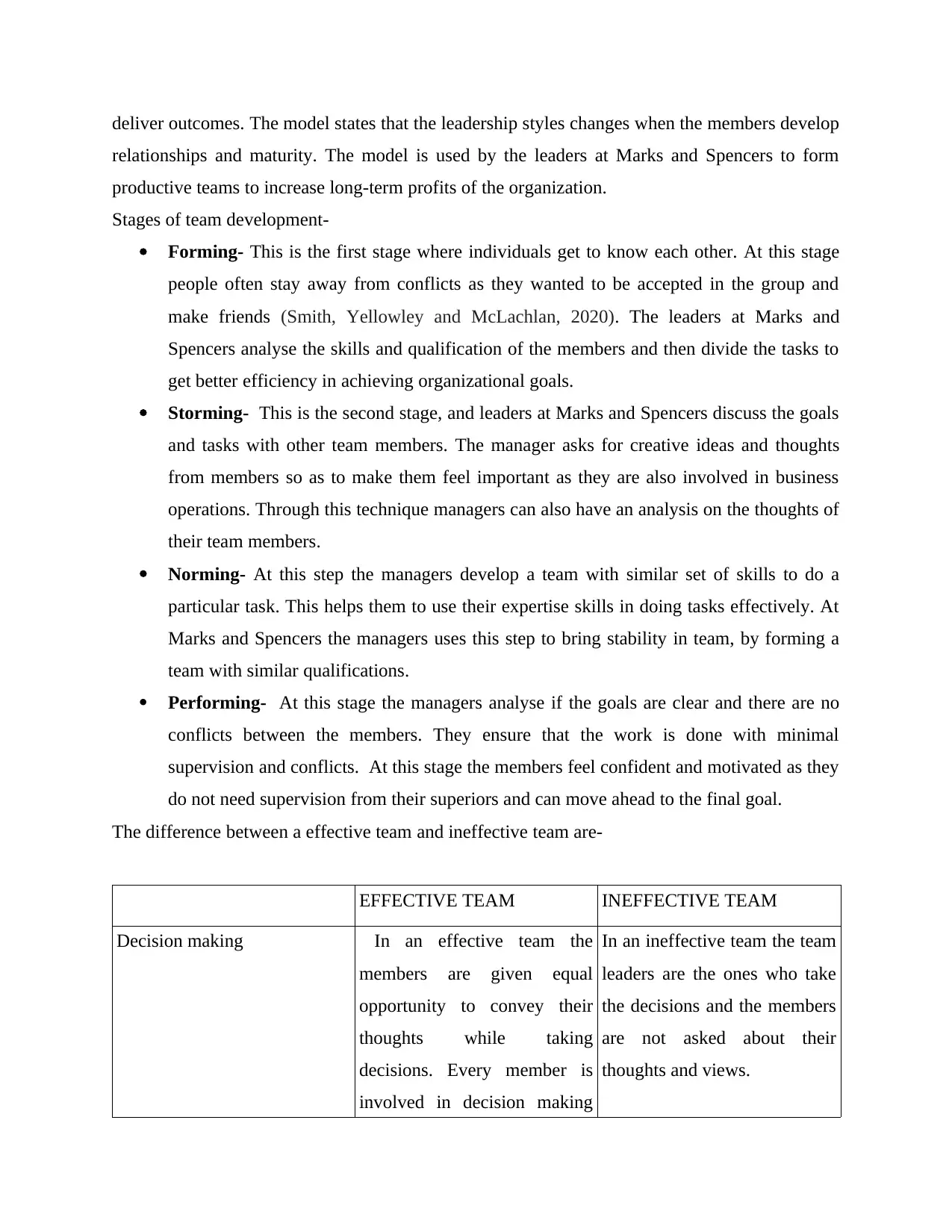
deliver outcomes. The model states that the leadership styles changes when the members develop
relationships and maturity. The model is used by the leaders at Marks and Spencers to form
productive teams to increase long-term profits of the organization.
Stages of team development-
Forming- This is the first stage where individuals get to know each other. At this stage
people often stay away from conflicts as they wanted to be accepted in the group and
make friends (Smith, Yellowley and McLachlan, 2020). The leaders at Marks and
Spencers analyse the skills and qualification of the members and then divide the tasks to
get better efficiency in achieving organizational goals.
Storming- This is the second stage, and leaders at Marks and Spencers discuss the goals
and tasks with other team members. The manager asks for creative ideas and thoughts
from members so as to make them feel important as they are also involved in business
operations. Through this technique managers can also have an analysis on the thoughts of
their team members.
Norming- At this step the managers develop a team with similar set of skills to do a
particular task. This helps them to use their expertise skills in doing tasks effectively. At
Marks and Spencers the managers uses this step to bring stability in team, by forming a
team with similar qualifications.
Performing- At this stage the managers analyse if the goals are clear and there are no
conflicts between the members. They ensure that the work is done with minimal
supervision and conflicts. At this stage the members feel confident and motivated as they
do not need supervision from their superiors and can move ahead to the final goal.
The difference between a effective team and ineffective team are-
EFFECTIVE TEAM INEFFECTIVE TEAM
Decision making In an effective team the
members are given equal
opportunity to convey their
thoughts while taking
decisions. Every member is
involved in decision making
In an ineffective team the team
leaders are the ones who take
the decisions and the members
are not asked about their
thoughts and views.
relationships and maturity. The model is used by the leaders at Marks and Spencers to form
productive teams to increase long-term profits of the organization.
Stages of team development-
Forming- This is the first stage where individuals get to know each other. At this stage
people often stay away from conflicts as they wanted to be accepted in the group and
make friends (Smith, Yellowley and McLachlan, 2020). The leaders at Marks and
Spencers analyse the skills and qualification of the members and then divide the tasks to
get better efficiency in achieving organizational goals.
Storming- This is the second stage, and leaders at Marks and Spencers discuss the goals
and tasks with other team members. The manager asks for creative ideas and thoughts
from members so as to make them feel important as they are also involved in business
operations. Through this technique managers can also have an analysis on the thoughts of
their team members.
Norming- At this step the managers develop a team with similar set of skills to do a
particular task. This helps them to use their expertise skills in doing tasks effectively. At
Marks and Spencers the managers uses this step to bring stability in team, by forming a
team with similar qualifications.
Performing- At this stage the managers analyse if the goals are clear and there are no
conflicts between the members. They ensure that the work is done with minimal
supervision and conflicts. At this stage the members feel confident and motivated as they
do not need supervision from their superiors and can move ahead to the final goal.
The difference between a effective team and ineffective team are-
EFFECTIVE TEAM INEFFECTIVE TEAM
Decision making In an effective team the
members are given equal
opportunity to convey their
thoughts while taking
decisions. Every member is
involved in decision making
In an ineffective team the team
leaders are the ones who take
the decisions and the members
are not asked about their
thoughts and views.
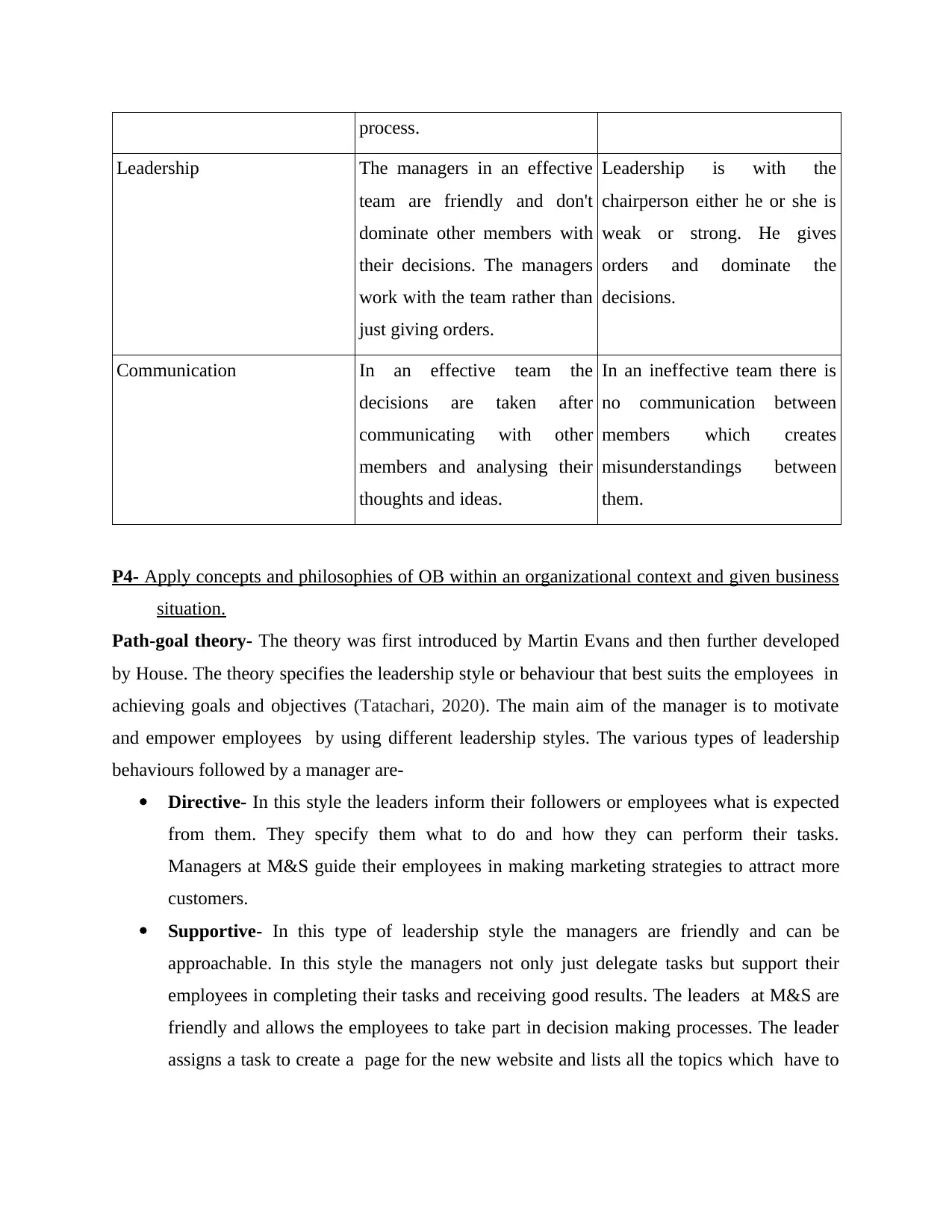
process.
Leadership The managers in an effective
team are friendly and don't
dominate other members with
their decisions. The managers
work with the team rather than
just giving orders.
Leadership is with the
chairperson either he or she is
weak or strong. He gives
orders and dominate the
decisions.
Communication In an effective team the
decisions are taken after
communicating with other
members and analysing their
thoughts and ideas.
In an ineffective team there is
no communication between
members which creates
misunderstandings between
them.
P4- Apply concepts and philosophies of OB within an organizational context and given business
situation.
Path-goal theory- The theory was first introduced by Martin Evans and then further developed
by House. The theory specifies the leadership style or behaviour that best suits the employees in
achieving goals and objectives (Tatachari, 2020). The main aim of the manager is to motivate
and empower employees by using different leadership styles. The various types of leadership
behaviours followed by a manager are-
Directive- In this style the leaders inform their followers or employees what is expected
from them. They specify them what to do and how they can perform their tasks.
Managers at M&S guide their employees in making marketing strategies to attract more
customers.
Supportive- In this type of leadership style the managers are friendly and can be
approachable. In this style the managers not only just delegate tasks but support their
employees in completing their tasks and receiving good results. The leaders at M&S are
friendly and allows the employees to take part in decision making processes. The leader
assigns a task to create a page for the new website and lists all the topics which have to
Leadership The managers in an effective
team are friendly and don't
dominate other members with
their decisions. The managers
work with the team rather than
just giving orders.
Leadership is with the
chairperson either he or she is
weak or strong. He gives
orders and dominate the
decisions.
Communication In an effective team the
decisions are taken after
communicating with other
members and analysing their
thoughts and ideas.
In an ineffective team there is
no communication between
members which creates
misunderstandings between
them.
P4- Apply concepts and philosophies of OB within an organizational context and given business
situation.
Path-goal theory- The theory was first introduced by Martin Evans and then further developed
by House. The theory specifies the leadership style or behaviour that best suits the employees in
achieving goals and objectives (Tatachari, 2020). The main aim of the manager is to motivate
and empower employees by using different leadership styles. The various types of leadership
behaviours followed by a manager are-
Directive- In this style the leaders inform their followers or employees what is expected
from them. They specify them what to do and how they can perform their tasks.
Managers at M&S guide their employees in making marketing strategies to attract more
customers.
Supportive- In this type of leadership style the managers are friendly and can be
approachable. In this style the managers not only just delegate tasks but support their
employees in completing their tasks and receiving good results. The leaders at M&S are
friendly and allows the employees to take part in decision making processes. The leader
assigns a task to create a page for the new website and lists all the topics which have to
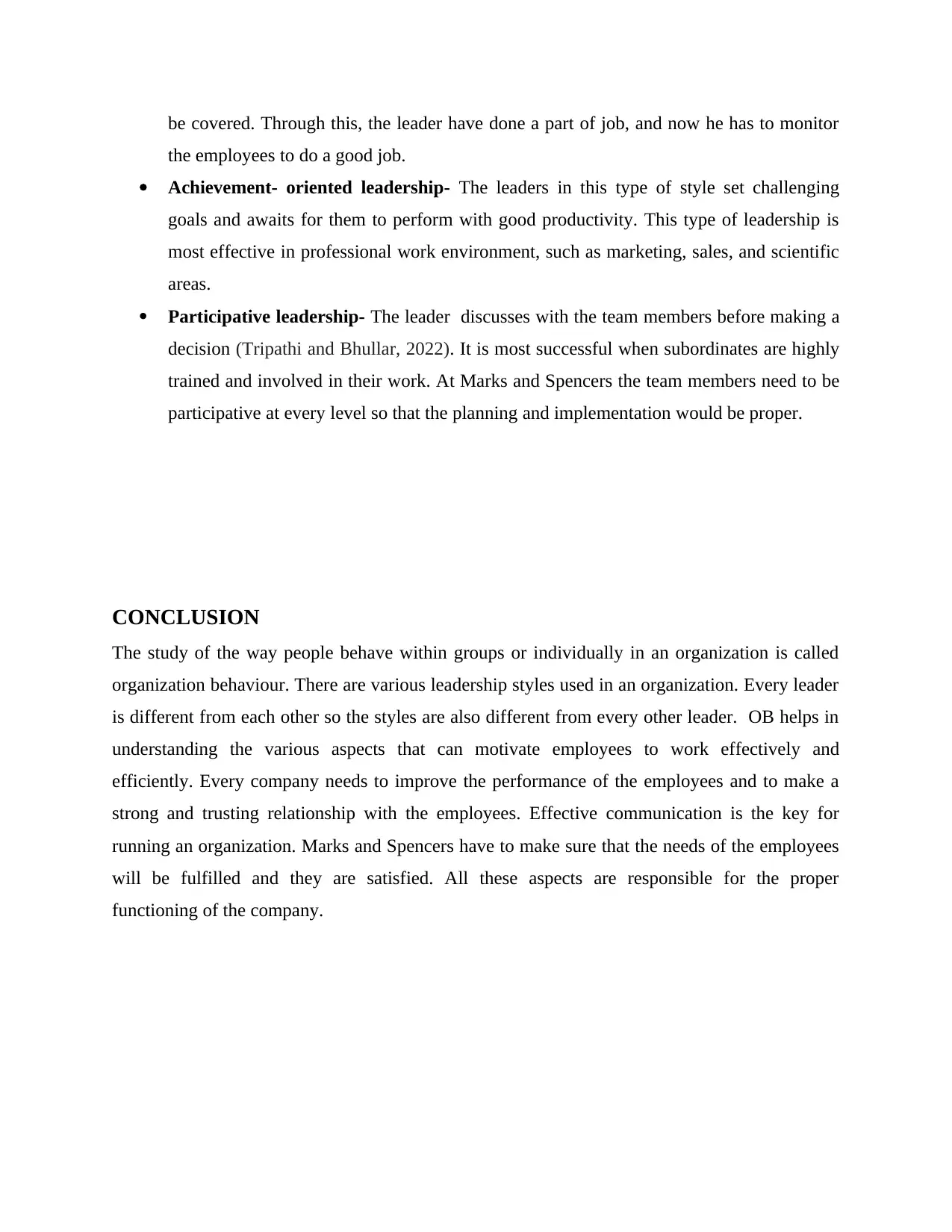
be covered. Through this, the leader have done a part of job, and now he has to monitor
the employees to do a good job.
Achievement- oriented leadership- The leaders in this type of style set challenging
goals and awaits for them to perform with good productivity. This type of leadership is
most effective in professional work environment, such as marketing, sales, and scientific
areas.
Participative leadership- The leader discusses with the team members before making a
decision (Tripathi and Bhullar, 2022). It is most successful when subordinates are highly
trained and involved in their work. At Marks and Spencers the team members need to be
participative at every level so that the planning and implementation would be proper.
CONCLUSION
The study of the way people behave within groups or individually in an organization is called
organization behaviour. There are various leadership styles used in an organization. Every leader
is different from each other so the styles are also different from every other leader. OB helps in
understanding the various aspects that can motivate employees to work effectively and
efficiently. Every company needs to improve the performance of the employees and to make a
strong and trusting relationship with the employees. Effective communication is the key for
running an organization. Marks and Spencers have to make sure that the needs of the employees
will be fulfilled and they are satisfied. All these aspects are responsible for the proper
functioning of the company.
the employees to do a good job.
Achievement- oriented leadership- The leaders in this type of style set challenging
goals and awaits for them to perform with good productivity. This type of leadership is
most effective in professional work environment, such as marketing, sales, and scientific
areas.
Participative leadership- The leader discusses with the team members before making a
decision (Tripathi and Bhullar, 2022). It is most successful when subordinates are highly
trained and involved in their work. At Marks and Spencers the team members need to be
participative at every level so that the planning and implementation would be proper.
CONCLUSION
The study of the way people behave within groups or individually in an organization is called
organization behaviour. There are various leadership styles used in an organization. Every leader
is different from each other so the styles are also different from every other leader. OB helps in
understanding the various aspects that can motivate employees to work effectively and
efficiently. Every company needs to improve the performance of the employees and to make a
strong and trusting relationship with the employees. Effective communication is the key for
running an organization. Marks and Spencers have to make sure that the needs of the employees
will be fulfilled and they are satisfied. All these aspects are responsible for the proper
functioning of the company.
Paraphrase This Document
Need a fresh take? Get an instant paraphrase of this document with our AI Paraphraser
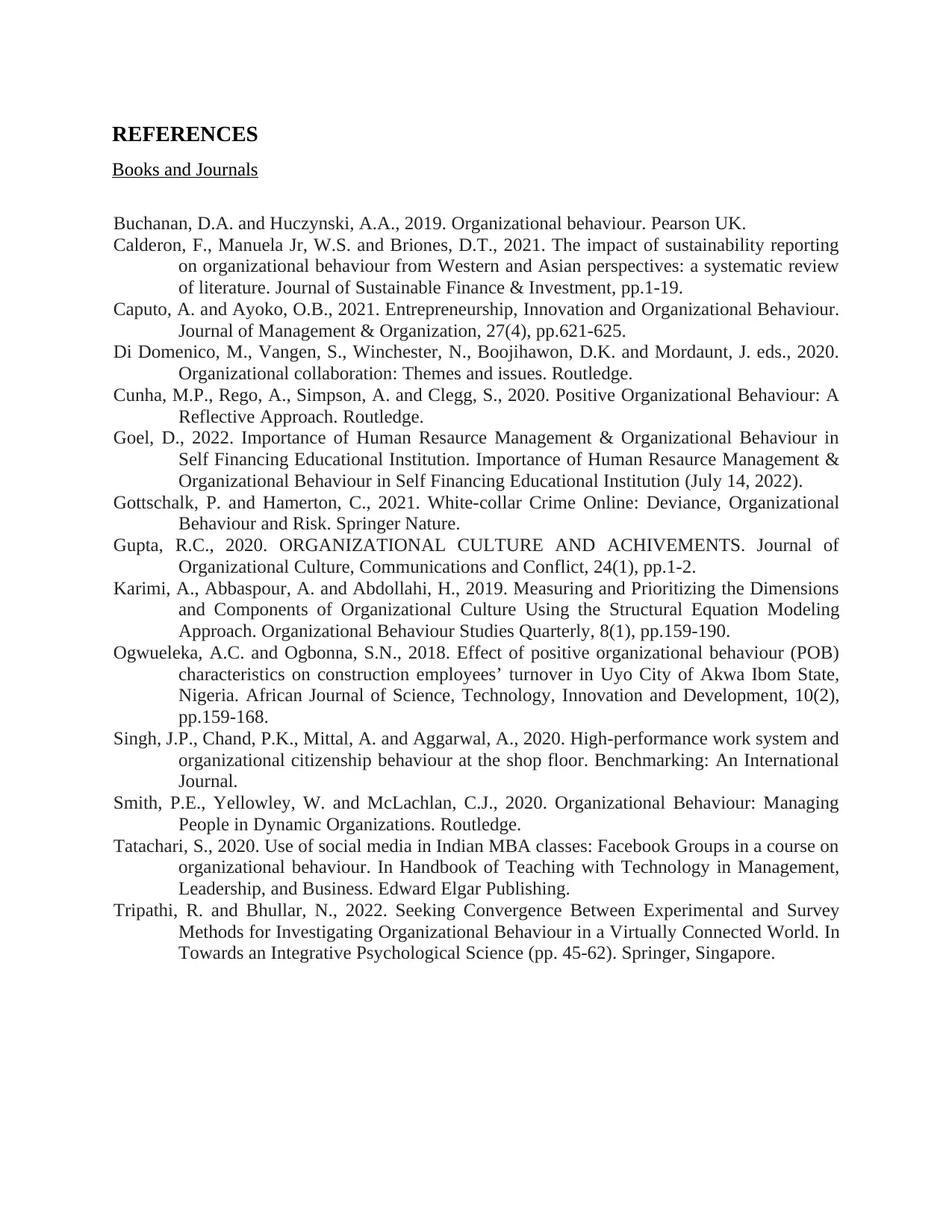
REFERENCES
Books and Journals
Buchanan, D.A. and Huczynski, A.A., 2019. Organizational behaviour. Pearson UK.
Calderon, F., Manuela Jr, W.S. and Briones, D.T., 2021. The impact of sustainability reporting
on organizational behaviour from Western and Asian perspectives: a systematic review
of literature. Journal of Sustainable Finance & Investment, pp.1-19.
Caputo, A. and Ayoko, O.B., 2021. Entrepreneurship, Innovation and Organizational Behaviour.
Journal of Management & Organization, 27(4), pp.621-625.
Di Domenico, M., Vangen, S., Winchester, N., Boojihawon, D.K. and Mordaunt, J. eds., 2020.
Organizational collaboration: Themes and issues. Routledge.
Cunha, M.P., Rego, A., Simpson, A. and Clegg, S., 2020. Positive Organizational Behaviour: A
Reflective Approach. Routledge.
Goel, D., 2022. Importance of Human Resaurce Management & Organizational Behaviour in
Self Financing Educational Institution. Importance of Human Resaurce Management &
Organizational Behaviour in Self Financing Educational Institution (July 14, 2022).
Gottschalk, P. and Hamerton, C., 2021. White-collar Crime Online: Deviance, Organizational
Behaviour and Risk. Springer Nature.
Gupta, R.C., 2020. ORGANIZATIONAL CULTURE AND ACHIVEMENTS. Journal of
Organizational Culture, Communications and Conflict, 24(1), pp.1-2.
Karimi, A., Abbaspour, A. and Abdollahi, H., 2019. Measuring and Prioritizing the Dimensions
and Components of Organizational Culture Using the Structural Equation Modeling
Approach. Organizational Behaviour Studies Quarterly, 8(1), pp.159-190.
Ogwueleka, A.C. and Ogbonna, S.N., 2018. Effect of positive organizational behaviour (POB)
characteristics on construction employees’ turnover in Uyo City of Akwa Ibom State,
Nigeria. African Journal of Science, Technology, Innovation and Development, 10(2),
pp.159-168.
Singh, J.P., Chand, P.K., Mittal, A. and Aggarwal, A., 2020. High-performance work system and
organizational citizenship behaviour at the shop floor. Benchmarking: An International
Journal.
Smith, P.E., Yellowley, W. and McLachlan, C.J., 2020. Organizational Behaviour: Managing
People in Dynamic Organizations. Routledge.
Tatachari, S., 2020. Use of social media in Indian MBA classes: Facebook Groups in a course on
organizational behaviour. In Handbook of Teaching with Technology in Management,
Leadership, and Business. Edward Elgar Publishing.
Tripathi, R. and Bhullar, N., 2022. Seeking Convergence Between Experimental and Survey
Methods for Investigating Organizational Behaviour in a Virtually Connected World. In
Towards an Integrative Psychological Science (pp. 45-62). Springer, Singapore.
Books and Journals
Buchanan, D.A. and Huczynski, A.A., 2019. Organizational behaviour. Pearson UK.
Calderon, F., Manuela Jr, W.S. and Briones, D.T., 2021. The impact of sustainability reporting
on organizational behaviour from Western and Asian perspectives: a systematic review
of literature. Journal of Sustainable Finance & Investment, pp.1-19.
Caputo, A. and Ayoko, O.B., 2021. Entrepreneurship, Innovation and Organizational Behaviour.
Journal of Management & Organization, 27(4), pp.621-625.
Di Domenico, M., Vangen, S., Winchester, N., Boojihawon, D.K. and Mordaunt, J. eds., 2020.
Organizational collaboration: Themes and issues. Routledge.
Cunha, M.P., Rego, A., Simpson, A. and Clegg, S., 2020. Positive Organizational Behaviour: A
Reflective Approach. Routledge.
Goel, D., 2022. Importance of Human Resaurce Management & Organizational Behaviour in
Self Financing Educational Institution. Importance of Human Resaurce Management &
Organizational Behaviour in Self Financing Educational Institution (July 14, 2022).
Gottschalk, P. and Hamerton, C., 2021. White-collar Crime Online: Deviance, Organizational
Behaviour and Risk. Springer Nature.
Gupta, R.C., 2020. ORGANIZATIONAL CULTURE AND ACHIVEMENTS. Journal of
Organizational Culture, Communications and Conflict, 24(1), pp.1-2.
Karimi, A., Abbaspour, A. and Abdollahi, H., 2019. Measuring and Prioritizing the Dimensions
and Components of Organizational Culture Using the Structural Equation Modeling
Approach. Organizational Behaviour Studies Quarterly, 8(1), pp.159-190.
Ogwueleka, A.C. and Ogbonna, S.N., 2018. Effect of positive organizational behaviour (POB)
characteristics on construction employees’ turnover in Uyo City of Akwa Ibom State,
Nigeria. African Journal of Science, Technology, Innovation and Development, 10(2),
pp.159-168.
Singh, J.P., Chand, P.K., Mittal, A. and Aggarwal, A., 2020. High-performance work system and
organizational citizenship behaviour at the shop floor. Benchmarking: An International
Journal.
Smith, P.E., Yellowley, W. and McLachlan, C.J., 2020. Organizational Behaviour: Managing
People in Dynamic Organizations. Routledge.
Tatachari, S., 2020. Use of social media in Indian MBA classes: Facebook Groups in a course on
organizational behaviour. In Handbook of Teaching with Technology in Management,
Leadership, and Business. Edward Elgar Publishing.
Tripathi, R. and Bhullar, N., 2022. Seeking Convergence Between Experimental and Survey
Methods for Investigating Organizational Behaviour in a Virtually Connected World. In
Towards an Integrative Psychological Science (pp. 45-62). Springer, Singapore.
1 out of 14
Your All-in-One AI-Powered Toolkit for Academic Success.
+13062052269
info@desklib.com
Available 24*7 on WhatsApp / Email
![[object Object]](/_next/static/media/star-bottom.7253800d.svg)
Unlock your academic potential
© 2024 | Zucol Services PVT LTD | All rights reserved.




